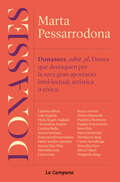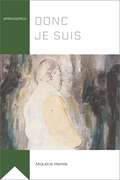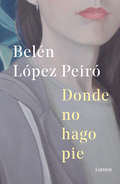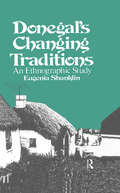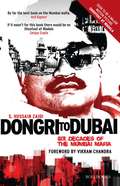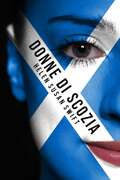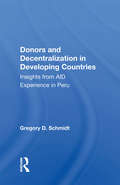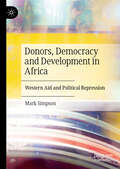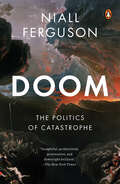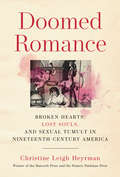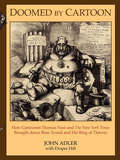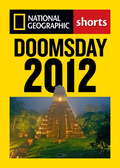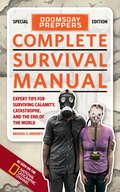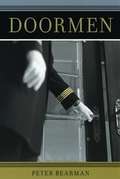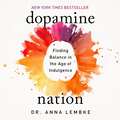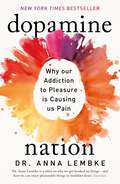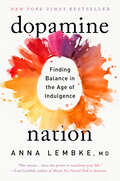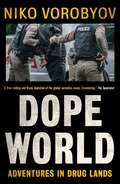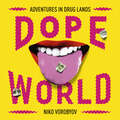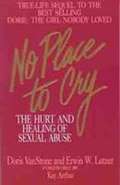- Table View
- List View
Donasses: Vint-i-dues dones de pes, protagonistes de la Catalunya moderna
by Marta PessarrodonaSi Pla tenia homenots la Marta té donasses, una munió de dones admirables i admirades a les quals ella ha sabut atribuir-los expressament el mot que les defineix. El títol ha donat peu a l'entrada donassa [donása] al Diccionari Normatiu Valencià, «f. Dona que destaca per la seua gran aportació intel·lectual, artística o cívica». Dolors Montserdà, Carmen Karr, Caterina Albert, Francesca Bonnemaison, Margarita Xirgu, Clementina Arderiu, Aurora Bertrana, Lola Anglada, Conxita Badia, Hermínia Grau, Frederica Montseny, Paulina Pi de la Serra, Remedios Varo, Mercè Rodoreda, Irene Polo, Carme Serrallonga, Carme Leveroni, Aurora Díaz Plaja, Maria Aurèlia Capmany, Maria Àngels Anglada, Mercè Vilaret i Montserrat Roig: descobrim les vides de les protagonistes de la Catalunya moderna des d'una perspectiva informativa molt entretinguda i divertida que capta la complicitat del lector i hi dialoga.Un clàssic de les lletres catalanes revisat i actualitzat amb un epíleg en què s'inclouen totes les donasses que ens han deixat d'ençà de la primera edició de l'any 2006 a Destino.
Donc je suis (Philosophica)
by Maurice HenrieIci, écrire rime avec réfléchir, et avec exister. Brefs, compacts et chargés, ces vingt-cinq essais philosophiques, qui entremêlent contemplation, opinion, souvenir, et sont magnifiquement couronnés d’exergues tirés de la grande littérature universelle. Ils traduisent une urgence existentielle d’immortaliser noir sur blanc sa pensée, une fébrilité de dire à peine dissimulée dans la main qui tient le stylo, mais aussi un poids de vivre devant le temps qui passe trop vite. D’un essai à l’autre, Henrie aborde les sujets qui lui sont les plus chers : le vieillissement de l’esprit, le consentement aux lois de la nature qui nous dominent depuis la naissance jusqu’à la mort, une théorie de l’opacité, de la dureté et de la sonorité, la lutte contre l’éparpillement de l’être.L’essayiste se prononce également sur des sujets plus actuels, comme le phénomène des temples de la renommée, la robotisation envahissante, le mystère de l’engouement pour les œuvres d’art. Il se montre particulièrement clairvoyant quand il parle de la gestion du mérite ou du sort déplorable que la société réserve aux artistes, en particulier les écrivains.Donc je suis est un ouvrage remarquable, où l’imaginaire, la rêverie et la pensée philosophique règnent en rois. À lire, à la lueur de la flamme d’une chandelle…Découvrez la version livre audio de ce titre, lu en version intégrale par Étienne Panet-Raymond. (Disponible à l’été 2019)
Donde no hago pie
by Belén López PeiróCrónica del duro proceso que sigue a la denuncia de un abuso familiar y que implica enfrentar los prejuicios de la sociedad y los obstáculos de la justicia. «Contemporáneo en su estilo breve y fragmentario -donde se cruzan diario, imágenes, géneros y lenguajes diversos-, esta novela lírica y vertiginosa revoluciona la no ficción en sus formas y temas».Gabriela Cabezón Cámara Después de un año sin noticias, una llamada desde la Fiscalía anuncia que, finalmente, la denuncia por abuso sexual ha sido elevada a juicio. Esa mañana invernal comienza para la narradora otro duro proceso: encontrar representación legal, entender las lógicas burocráticas de la Justicia, tejer redes de apoyo para afrontar la causa contra su tío, un comisario poderoso, y juntar coraje para reabrir un expediente que lleva al pasado familiar. Sin demagogias, Belén López Peiró revisa los contornos difusos de los recuerdos; ensaya respuestas al agobio de audiencias humillantes e indaga en los laberintos de los juicios por jurado. Donde no hago pie profundiza el proyecto literario de Por qué volvías cada verano, antecedente clave de miles de denuncias anónimas y otras de enorme repercusión mediática. Con un ritmo avasallante, esta crónica encuentra las palabras para transformar en acción política un delito que pretendía permanecer secreto. Sobre Por qué volvías cada verano, la crítica dijo: «Uno de los 18 mejores libros del año».Revista Rolling Stone «De una contundencia expresiva increíble».Mauro Libertella, La Agenda «Una de las autoras del año».Carolina Amoroso, TN «Uno de los textos más valientes y más crudos que apareció recientemente».Agustina Larrea, Infobae
Donegal's Changing Traditions: An Ethnographic Study (The Library of Anthropology #Vol. 8)
by Eugenia ShanklinFirst Published in 1985. Routledge is an imprint of Taylor & Francis, an informa company.
Dongri to Dubai - Six Decades of the Mumbai Mafia: Six Decades Of The Mumbai Mafia
by S. Hussain ZaidiDongri to Dubai is the first ever attempt to chronicle the history of the Mumbai mafia. It is the story of notorious gangsters like Haji Mastan, Karim Lala, Varadarajan Mudaliar, Chhota Rajan, Abu Salem, but above all, it is the story of a young man who went astray despite having a father in the police force. Dawood Ibrahim was initiated into crime as a pawn in the hands of the Mumbai police and went on to wipe out the competition and eventually became the Mumbai police’s own nemesis.The narrative encompasses several milestones in the history of crime in India, from the rise of the Pathans, formation of the Dawood gang, the first ever supari, mafia’s nefarious role in Bollywood, Dawood’s move to Karachi, and Pakistan’s subsequent alleged role in sheltering one of the most wanted persons in the world. This story is primarily about how a boy from Dongri became a don in Dubai, and captures his bravado, focus, ambition, and lust for power in a gripping narrative. The meticulously researched book provides an in-depth and comprehensive account of the mafia’s games of supremacy and internecine warfare.
Donne di Scozia
by Lara Carpinelli Helen Susan SwiftDonne di Scozia è un viaggio nel tempo attraverso la storia scozzese per svelare l’importante ruolo svolto dalle donne. Dalle più umili a quelle straordinarie, le donne scozzesi sono state in prima fila e sullo sfondo degli eventi: le pescivendole, le combattenti, le grandi scrittrici, le giacobite, le martiri e le operaie. Senza di loro, la Scozia non sarebbe esistita. Goditi questo grande viaggio dai secoli bui al XXI secolo e incontra le donne che sono state la forza motrice di una nazione piccola ma dinamica.
Donnie Brasco
by Joseph D. Pistone Richard WoodleyDonnie Brasco is Pistone's unforgettable account of how be became part of the mysterious underworld that is the Mafia--the first and only account by a law enforcement agent--and it is amazing and intriguing as the flamboyant, deadly world it portrays.
Donors And Decentralization In Developing Countries: Insights From Aid Experience In Peru
by Gregory D. SchmidtThis book examines the United States Agency for International Development's efforts to address concerns that have been raised in the literature about the ability of international donors to support Peruvian decentralization in developing countries. .
Donors, Democracy and Development in Africa: Western Aid and Political Repression
by Mark SimpsonUganda, Ethiopia and Rwanda have figured prominently in the post- Cold War relations between Western donors and Sub-Saharan Africa. Their ‘new leaders’ were embraced by Western countries as the antithesis of former Cold War-era African strongmen, and their countries became ‘donor darlings’, benefitting from regular and significant inflows of Western development assistance. To the dismay of African democracy activists and human rights defenders, such aid enabled the regimes in these countries to strengthen the repressive political and economic governance systems over which they preside. Using a multi-disciplinary approach, this book examines the role of Western development assistance in supporting these authoritarian African regimes. It connects changing Western donor policies and priorities to developments within the three African countries, to the past of these ruling parties as armed liberation movements, to wider regional and global political, economic and strategic shifts, and highlights the skillful management by Kampala, Addis Ababa and Kigali of Western aid and international aid architecture to ensure regime preservation.
Donuts: An American Passion
by John T. EdgeFrom the author of "Fried Chicken, Apple Pie" and "Hamburgers & Fries" comes his newest work (with recipes): the history of the donut, from its inception as Dutch fare through today's fanatical chefs who take donuts to a new art form.
Doom: The Politics of Catastrophe
by Niall Ferguson"All disasters are in some sense man-made."Setting the annus horribilis of 2020 in historical perspective, Niall Ferguson explains why we are getting worse, not better, at handling disasters.Disasters are inherently hard to predict. Pandemics, like earthquakes, wildfires, financial crises. and wars, are not normally distributed; there is no cycle of history to help us anticipate the next catastrophe. But when disaster strikes, we ought to be better prepared than the Romans were when Vesuvius erupted, or medieval Italians when the Black Death struck. We have science on our side, after all. Yet in 2020 the responses of many developed countries, including the United States, to a new virus from China were badly bungled. Why? Why did only a few Asian countries learn the right lessons from SARS and MERS? While populist leaders certainly performed poorly in the face of the COVID-19 pandemic, Niall Ferguson argues that more profound pathologies were at work--pathologies already visible in our responses to earlier disasters.In books going back nearly twenty years, including Colossus, The Great Degeneration, and The Square and the Tower, Ferguson has studied the foibles of modern America, from imperial hubris to bureaucratic sclerosis and online fragmentation.Drawing from multiple disciplines, including economics, cliodynamics, and network science, Doom offers not just a history but a general theory of disasters, showing why our ever more bureaucratic and complex systems are getting worse at handing them.Doom is the lesson of history that this country--indeed the West as a whole--urgently needs to learn, if we want to handle the next crisis better, and to avoid the ultimate doom of irreversible decline.
Doomed Romance: Broken Hearts, Lost Souls, and Sexual Tumult in Nineteenth-Century America
by Christine Leigh HeyrmanFrom the winner of the Bancroft Prize and the Francis Parkman Prize in History, a lost episode rediscovered after almost two hundred years; a thwarted love triangle of heartbreak--two men and a woman of equal ambition--that exploded in scandal and investigation, set between America's Revolution and its Civil War, revealing an age in subtle and powerful transformation, caught between the fight for women's rights and the campaign waged by evangelical Protestants to dominate the nation's culture and politics.At its center--and the center of a love triangle--Martha Parker, a gifted young New England woman, smart, pretty, ambitious, determined to make the most of her opportunities, aspiring to become an educator and a foreign missionary.Late in 1825, Martha accepted a proposal from a schoolmaster, Thomas Tenney, only to reject him several weeks later for a rival suitor, a clergyman headed for the mission field, Elnathan Gridley. Tenney's male friends, deeply resentful of the new prominence of women in academies, benevolent and reform associations, and the mission field, decided to retaliate on Gridley's behalf by sending an anonymous letter to the head of the foreign missions board impugning Martha's character. Tenney further threatened Martha with revealing even more about their relationship, thereby ruining her future prospects as a missionary. The head of the board began an inquiry into the truth of the claims about Martha, and in so doing, collected letters, diaries, depositions, and firsthand witness accounts of Martha's character. The ruin of Martha Parker's hopes provoked a resistance within evangelical ranks over womanhood, manhood, and, surprisingly, homosexuality, ultimately threatening to destroy the foreign missions enterprise.
Doomed by Cartoon: How Cartoonist Thomas Nast and The New York Times Brought down Boss Tweed and His Ring of Thieves
by John Adler Draper HillThe timely, true story of Thomas Nast, the granddaddy of political satire who destroyed a corrupt regime in 19th century New York City—with cartoons. He was an unethical, bullying, and narcissistic politician; a blow-hard real estate magnate and notorious swindler; a master manipulator who thrived off voter fraud, graft, and the collusion of his right-hand sycophants. This is the 1870s. The legendary William &“Boss&” Tweed, senator and third-largest landowner in New York City, is on a roll. He and his thieving minions have already duped the city out of an estimated two-billion dollars. It wasn&’t going to be easy exposing him. He controlled the press—except for the magazine, Harper&’s Weekly. And Harper&’s had an invaluable weapon against the humorless and seemingly invincible Tweed: Thomas Nast, an influential political cartoonist who, day by day, brought Tweed&’s corruption to light. With pen and ink, and a savage and righteous wink, Thomas Nast was determined to topple an empire. Told through Nast&’s scathing 160-plus serialized cartoons, the remarkable and unbelievable true story of Nast vs. Tweed was not only unprecedented for its day, but it set the tone for the battle between the freedom of the press and political malfeasance that resonates well into the twenty-first century.
Doomsday 2012: The Maya Calendar and the History of the End of the World
by Catherine ZuckermanThe Maya calendar started on August 11, 3114 BCE (corresponding date in the proleptic Gregorian calendar) and ends on December 21, 2012. Will it be Armageddon or just another day? The believers are making survival preparations and turning to religious leaders for guidance and solace. Follow National Geographic through the maze of doomsday prophets, cult leaders, and international and historic end times teachings to understand the science behind the Maya calendar and the phenomenon of Armageddon predictions. Scientists and historians know that end-of-days thinking has occurred throughout time around the world. Norse mythology predicted the world would be submerged in water; ancient Greeks believed that Zeus's defeat by his son would be the grand finale. In A.D. 79, Romans thought Mount Vesuvius's eruption in Pompeii was the start of the apocalypse. Jewish, Christian, and Islamic texts all include some writing about end times. The year 1666 - feared by many Christians - proved itself to be the year of the Beast when the Great Fire of London visited God's wrath (as widely believed) on the British. Hailey's Comet drove Europeans and Americans into apocalyptic fits in 1910. Individual charismatic figures have led thousands in unfulfilled Armageddon watches. For example, in 1843, spiritual leader William Miller's doomsday prediction failed (The Great Disappointment), but led followers to establish the Seventh Day Adventists. The Jehovah's Witnesses awaited the world's end in 1914. Preacher Jim Jones led hundreds of cult members to commit suicide in Ghana in the 1970s. Pat Robertson was certain Jesus was returning for the Rapture in the 1980s. The leader of the cult Heaven's Gate convinced 39 followers to commit suicide to escape imminent destruction in 1997. And there's no sign of a slow down. In fact, the Internet has spawned a plethora of doomsday cult leaders, from Y2K hysterics to the most recent religious figure Harold Camping, whose rapture predictions of 2011 left his followers earth-bound.
Doomsday Preppers Complete Survival Manual
by Michael SweeneyThis custom companion to the blockbuster National Geographic Channel series Doomsday Preppersis filled with how-to illustrations, "Prepper Profiles" of people in the show, and survival tips from preppers themselves. Handy and comprehensive, the manual offers valuable life-saving information to help prepare for the most devastating calamities. Episodes of this highly original show, which debuted in February 2012, explore the lives of otherwise ordinary Americans who are preparing for the end of the world as we know it. Preppers go to extraordinary lengths to plan for any of life's uncertainties, from constructing a home out of shipping containers and stockpiling 50,000 lbs. of food to practicing evacuation drills and hand-to-hand combat. This book is an essential component.
Doormen
by Peter BearmanLittle fascinates New Yorkers more than doormen, who know far more about tenants than tenants know about them. Doormen know what their tenants eat, what kind of movies they watch, whom they spend time with, whether they drink too much, and whether they have kinky sex. But if doormen are unusually familiar with their tenants, they are also socially very distant. In Doormen, Peter Bearman untangles this unusual dynamic to reveal the many ways that tenants and doormen negotiate their complex relationship. Combining observation, interviews, and survey information, Doormen provides a deep and enduring ethnography of the occupational role of doormen, the dynamics of the residential lobby, and the mundane features of highly consequential social exchanges between doormen and tenants. Here, Bearman explains why doormen find their jobs both boring and stressful, why tenants feel anxious about how much of a Christmas bonus their neighbors give, and how everyday transactions small and large affect tenants' professional and informal relationships with doormen. In the daily life of the doorman resides the profound, and this book provides a brilliant account of how tenants and doormen interact within the complex world of the lobby.
Dopamine Nation: Finding Balance in the Age of Indulgence
by Dr Anna LembkeAll around us people are looking at their phones too much, eating too much, drinking too much. Our world is addicted to fleeting distracting pleasures that get us nowhere. Dr Anna Lembke provides a clear way back to a balanced life.This audiobook is about pleasure. It's also about pain. Most importantly, it's about how to find the delicate balance between the two, and why now more than ever finding balance is essential. We're living in a time of unprecedented access to high-reward, high-dopamine stimuli: drugs, food, news, gambling, shopping, gaming, texting, sexting, Facebooking, Instagramming, YouTubing, tweeting... The increased numbers, variety, and potency is staggering. The smartphone is the modern-day hypodermic needle, delivering digital dopamine 24/7 for a wired generation. As such we've all become vulnerable to compulsive overconsumption.In Dopamine Nation, Dr. Anna Lembke, psychiatrist and author, explores the exciting new scientific discoveries that explain why the relentless pursuit of pleasure leads to pain...and what to do about it. Condensing complex neuroscience into easy-to-understand metaphors, Lembke illustrates how finding contentment and connectedness means keeping dopamine in check. The lived experiences of her patients are the gripping fabric of her narrative. Their riveting stories of suffering and redemption give us all hope for managing our consumption and transforming our lives. In essence, Dopamine Nation shows that the secret to finding balance is combining the science of desire with the wisdom of recovery.'Dr Anna Lembke is a whiz on why we get hooked on things - and how we can enjoy pleasurable things in healthier doses.' - The Guardian(P) 2021 Penguin Random House Audio
Dopamine Nation: Finding Balance in the Age of Indulgence
by Dr Anna Lembke'Her stories have the power to transform your life' Lori Gottlieb, bestselling author of Maybe You Should Talk to Someone 'Radically changes the way we think about mental illness, pleasure, pain, reward and stress' Daniel Levitin, bestselling author of The Organized MindTHE NEW YORK TIMES AND SUNDAY TIMES BESTSELLER We are a wired generation. In these fast-paced times we are constantly bombarded by high-reward, high-dopamine stimuli. From texting to social media, food to drugs, gambling to shopping, we have become addicted to fleeting and distracting pleasures that are making us sick.In Dopamine Nation, psychiatrist and bestselling author Dr Anna Lembke reveals why our relentless pursuit of pleasure leads to pain and what we can do about it. Bringing together cutting-edge neuroscience with the gripping real life experiences from her clinical practice, Lembke explores how contentment and connectedness are essential tools in keeping dopamine in check. This is an essential book for anyone wanting to find a balance for a happier life.
Dopamine Nation: Finding Balance in the Age of Indulgence
by Dr. Anna LembkeINSTANT NEW YORK TIMES and LOS ANGELES TIMES BESTSELLER&“Brilliant . . . riveting, scary, cogent, and cleverly argued.&”—Beth Macy, author of Dopesick,as heard on Fresh AirThis book is about pleasure. It&’s also about pain. Most important, it&’s about how to find the delicate balance between the two, and why now more than ever finding balance is essential. We&’re living in a time of unprecedented access to high-reward, high-dopamine stimuli: drugs, food, news, gambling, shopping, gaming, texting, sexting, Facebooking, Instagramming, YouTubing, tweeting . . . The increased numbers, variety, and potency is staggering. The smartphone is the modern-day hypodermic needle, delivering digital dopamine 24/7 for a wired generation. As such we&’ve all become vulnerable to compulsive overconsumption. In Dopamine Nation, Dr. Anna Lembke, psychiatrist and author, explores the exciting new scientific discoveries that explain why the relentless pursuit of pleasure leads to pain . . . and what to do about it. Condensing complex neuroscience into easy-to-understand metaphors, Lembke illustrates how finding contentment and connectedness means keeping dopamine in check. The lived experiences of her patients are the gripping fabric of her narrative. Their riveting stories of suffering and redemption give us all hope for managing our consumption and transforming our lives. In essence, Dopamine Nation shows that the secret to finding balance is combining the science of desire with the wisdom of recovery.
Dopeworld: Adventures in Drug Lands
by Niko VorobyovWelcome to Dopeworld. Ecstasy in London, crack in Los Angeles, LSD in Tokyo, heroin in Sofia, cocaine in Medellin, bounty hunting in Manilla, opium in Tehran. Get ready for your next fix. __________Dopeworld is a bold and intoxicating journey into the world of drugs. From the cocaine farms in South America to the streets of Manila, we trace the emergence of psychoactive substances and our intimate relationship with them. With unparalleled access to drug lords, cartel leaders, street dealers and government officials, Niko Vorobyov attempts to shine a light on the dark underbelly drug world.At once a bold piece of reportage and a hugely entertaining and perverse travelogue, Dopeworld reveals how drug use is at the heart of our history, our lives, and our world.__________ With echoes of Gomorrah and Fear and Loathing in Last Vegas, Dopeworld is a brilliant and enlightening journey across the world, examining every angle of the drug war.
Dopeworld: Adventures in Drug Lands
by Niko Vorobyov'A free-rolling and frank depiction of the global narcotics scene. Fascinating.' The Spectator'This is an obsessive, immersive account of all aspects of the drug culture - its ways, its rules, its rituals, its rhythms, its language.' Irish ExaminerWelcome to Dopeworld. Ecstasy in London, crack in Los Angeles, LSD in Tokyo, heroin in Sofia, cocaine in Medellin, bounty hunting in Manilla, opium in Tehran. Get ready for your next fix. __________Dopeworld is a bold and intoxicating journey into the world of drugs. From the cocaine farms in South America to the streets of Manila, we trace the emergence of psychoactive substances and our intimate relationship with them. With unparalleled access to drug lords, cartel leaders, street dealers and government officials, Niko Vorobyov attempts to shine a light on the dark underbelly drug world.At once a bold piece of reportage and a hugely entertaining and perverse travelogue, Dopeworld reveals how drug use is at the heart of our history, our lives, and our world.__________ With echoes of Gomorrah and Fear and Loathing in Last Vegas, Dopeworld is a brilliant and enlightening journey across the world, examining every angle of the drug war.
Doping in Sport: Global Ethical Issues (Sport In The Global Society Ser.)
by Angela J. SchneiderThis book considers ethical arguments about performance enhancing drugs in sport in a global context. It examines:* The forces that are bringing about the debate of ethical issues in performance enhancing drugs in sport* The sources of ethical debates in different continents and countries * The variation of ethical arguments in different cultural, political, ideological and sports systems.Whilst there has been a significant body of work that has looked at the importance of ethical issues in performance enhancing drugs in sport - there has been little, if any, consideration of the various ethical concepts in different countries and cultures involving sport. This is a major omission. This book fills the gap and provides a thorough review and analysis of the ethical literature on performance enhancing drugs in sport in the global society. It makes a major contribution to the worldwide anti-doping campaign in sport.This volume was previously published as a special issue of the journal Sport In Global Society.
Doppelganger: A Trip into the Mirror World
by Naomi KleinA finalist for the 2023 National Book Critics Circle AwardWinner of the Women's Prize for NonfictionNEW YORK TIMES BESTSELLER | National Indie BestsellerA New York Times notable book of 2023 | Vulture’s #1 book of 2023One of Slate’s ten best books of 2023 | A Guardian best ideas book of 2023 | One of Time’s ten best books of 2023 | Winner of the Pacific Northwest Book Award“I’ve been raving about Naomi Klein’s Doppelganger . . . I can’t think of another text that better captures the berserk period we’re living through.” —Michelle Goldberg, The New York Times“If I had to name a single book that makes sense of these last few dark years, it would be this one.” —Katie Roiphe, The New York Times Book Review (Editors’ Choice)What if you woke up one morning and found you’d acquired another self—a double who was almost you and yet not you at all? What if that double shared many of your preoccupations but, in a twisted, upside-down way, furthered the very causes you’d devoted your life to fighting against?Not long ago, the celebrated activist and public intellectual Naomi Klein had just such an experience—she was confronted with a doppelganger whose views she found abhorrent but whose name and public persona were sufficiently similar to her own that many people got confused about who was who. Destabilized, she lost her bearings, until she began to understand the experience as one manifestation of a strangeness many of us have come to know but struggle to define: AI-generated text is blurring the line between genuine and spurious communication; New Age wellness entrepreneurs turned anti-vaxxers are scrambling familiar political allegiances of left and right; and liberal democracies are teetering on the edge of absurdist authoritarianism, even as the oceans rise. Under such conditions, reality itself seems to have become unmoored. Is there a cure for our moment of collective vertigo?Naomi Klein is one of our most trenchant and influential social critics, an essential analyst of what branding, austerity, and climate profiteering have done to our societies and souls. Here she turns her gaze inward to our psychic landscapes, and outward to the possibilities for building hope amid intersecting economic, medical, and political crises. With the assistance of Sigmund Freud, Jordan Peele, Alfred Hitchcock, and bell hooks, among other accomplices, Klein uses wry humor and a keen sense of the ridiculous to face the strange doubles that haunt us—and that have come to feel as intimate and proximate as a warped reflection in the mirror.Combining comic memoir with chilling reportage and cobweb-clearing analysis, Klein seeks to smash that mirror and chart a path beyond despair. Doppelganger asks: What do we neglect as we polish and perfect our digital reflections? Is it possible to dispose of our doubles and overcome the pathologies of a culture of multiplication? Can we create a politics of collective care and undertake a true reckoning with historical crimes? The result is a revelatory treatment of the way many of us think and feel now—and an intellectual adventure story for our times.
Dorie: The Girl Nobody Loved
by Erwin W. Lutzer Doris Van StoneDorie grew up not knowing her father, her mother turned her back on her and sent her to an orphanage, and she had cruel foster parents after that, but God gave Dorie Van Stone a tender heart to forgive her emotional abusers. He also gave her a loving, caring husband and a life filled with purpose and meaning. You will gain insight into the trauma of emotional abuse.
Dornier Do 17 in the Battle of Britain: The 'Flying Pencil' in the Spitfire Summer
by Chris GossIn this comprehensive pictorial record of the Do 17, the bomber’s role throughout the period of the Battle of Britain is displayed in the author’s unique collection of British and German photographs.During Britain’s desperate struggle for survival that in the summer of 1940, the Dornier Do 17 played a prominent part in raids designed at neutralizing the RAF’s ability to resist and the British people’s will to fight back. Having been built to outrun contemporary fighters when introduced into the Luftwaffe in 1937, it had become the Luftwaffe’s main light bomber, and for the attack against Britain, three bomber wings, KG 2, KG3 and KG77, were equipped with the Do 17. But by 1940, the Do 17 was nearing obsolescence and, with its weak defensive armament, it fell prey to Fighter Command’s Hurricanes and Spitfires. Its vulnerability was starkly revealed on 18 August 1940, when eight Dorniers were shot down and nine damaged in attacks on RAF Kenley, and on 15 September – Battle of Britain Day – when twenty were shot down and a further thirteen damaged. On that day, Sergeant Ray Holmes rammed his Hurricane into a Do 17 that was reportedly aiming for Buckingham Palace. Part of the bomber’s wreckage fell to earth near Victoria Station. In this comprehensive pictorial record of the Do 17, the bomber’s role throughout the period of the Battle of Britain is displayed in the author’s unique collection of British and German photographs. These photographs, coupled with first-hand stories from those who flew and those who fought against the Do 17, bring those desperate days and dark nights back to life in the manner which only contemporary images and accounts can achieve.
